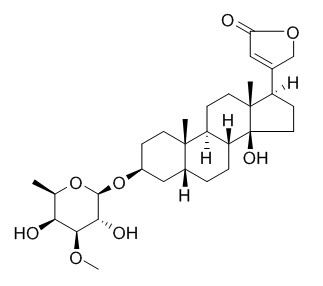Odoroside H
Odoroside H has anticancer activities, the cytotoxic effects are induced by the inhibition of the plasma membrane bound Na(+)/K(+)-ATPase.
Inquire / Order:
manager@chemfaces.com
Technical Inquiries:
service@chemfaces.com
Tel:
+86-27-84237783
Fax:
+86-27-84254680
Address:
1 Building, No. 83, CheCheng Rd., Wuhan Economic and Technological Development Zone, Wuhan, Hubei 430056, PRC
Providing storage is as stated on the product vial and the vial is kept tightly sealed, the product can be stored for up to
24 months(2-8C).
Wherever possible, you should prepare and use solutions on the same day. However, if you need to make up stock solutions in advance, we recommend that you store the solution as aliquots in tightly sealed vials at -20C. Generally, these will be useable for up to two weeks. Before use, and prior to opening the vial we recommend that you allow your product to equilibrate to room temperature for at least 1 hour.
Need more advice on solubility, usage and handling? Please email to: service@chemfaces.com
The packaging of the product may have turned upside down during transportation, resulting in the natural compounds adhering to the neck or cap of the vial. take the vial out of its packaging and gently shake to let the compounds fall to the bottom of the vial. for liquid products, centrifuge at 200-500 RPM to gather the liquid at the bottom of the vial. try to avoid loss or contamination during handling.
J Clin Transl Hepatol.2023, 11(4):863-876.
Food Chem.2018, 252:207-214
Cells.2021, 10(10):2633.
Planta Med.2018, 84(15):1101-1109
J Ginseng Res.2020, 44(4):611-618.
Plant Physiol.2023, 193(3):1758-1771.
Anal Bioanal Chem.2018, 410(5):1561-1569
J Cell Mol Med.2023, 27(10):1423-1435.
GxABT2022, 2268.2:15515.
J Pharmaceutical Research Int.2021, 33(41A):275-284.
Related and Featured Products
J Ethnopharmacol. 2011 Apr 12;134(3):781-8.
Characterization of the anticancer properties of monoglycosidic cardenolides isolated from Nerium oleander and Streptocaulon tomentosum.[Pubmed:
21291990]
For identification of the active constituents we investigated the anticancer activity of cardenolides from Streptocaulon tomentosum Wight & Arn. (Asclepiadaceae) and from Nerium oleander L. (Apocynaceae) which are both used against cancer in the traditional medicine in their region of origin.
METHODS AND RESULTS:
The antiproliferative activity of cardenolides isolated from roots of Streptocaulon tomentosum (IC(50)<1-15.3 μM after 2 days in MCF7) and of cardenolide containing fractions from the cold aqueous extract of Nerium oleander leaves ("Breastin", mean IC(50) 0.85 μg/ml in a panel of 36 human tumor cell lines), their influence on the cellular viability and on the cell cycle (block at the G2/M-phase or at the S-phase in tumor cells, respectively) were determined using different cell lines. The murine cell line L929 and normal non-tumor cells were not affected. Bioactivity guided fractionation of Breastin resulted in the isolation of the monoglycosidic cardenolides oleandrine, oleandrigeninsarmentoside, neritaloside, Odoroside H, and odoroside A (IC(50)-values between 0.010 and 0.071 μg/ml).
CONCLUSIONS:
The observed anticancer activities of extracts and isolated cardenolides are in agreement with the ethnomedicinal use of Streptocaulon tomentosum and Nerium oleander. The most active anticancer compounds from both species are monoglycosidic cardenolides possessing the 3β,14β-dihydroxy-5β-card-20(22)-enolide structure with or without an acetoxy group at C-16. The results indicate that the cytotoxic effects are induced by the inhibition of the plasma membrane bound Na(+)/K(+)-ATPase.
Phytochemistry. 1999 Feb;50(3):435-8.
Bio-active cardenolides from the leaves of Nerium oleander.[Pubmed:
9933955]
METHODS AND RESULTS:
A bioactivity directed isolation of the methanolic extract of the fresh, uncrushed leaves of Nerium oleander showing a central nervous system (CNS) depressant effect in mice has been undertaken. As a result, four CNS depressant cardenolides including a new cardenolide, neridiginoside and three known constituents, nerizoside, neritaloside and Odoroside H, have been isolated which exhibited CNS depressant activity in mice at a dose of 25 mg/kg. The structure of neridiginoside was elucidated as 3 beta-O-(D-diginosyl)-5 beta, 14 beta-dihydroxy-card-20(22)-enolide, using spectroscopic methods including one-dimensional and two-dimensional NMR (COSY-45, NOESY, J-resolved, HMQC and HMBC).
CONCLUSIONS:
The known compounds have been indentified through spectral studies and comparison of data with those reported in the literature.



